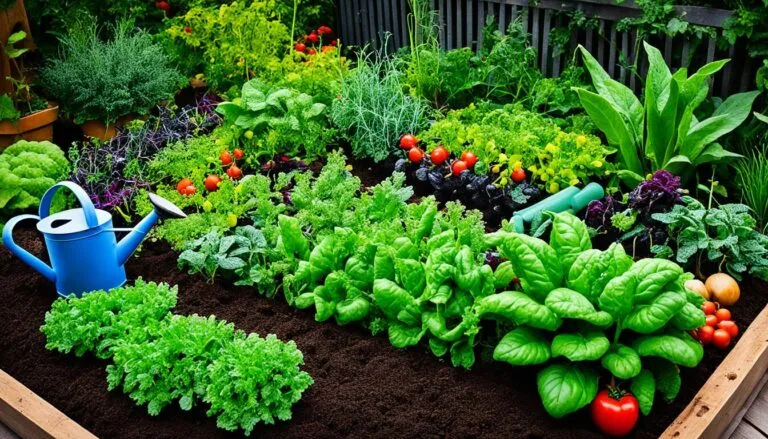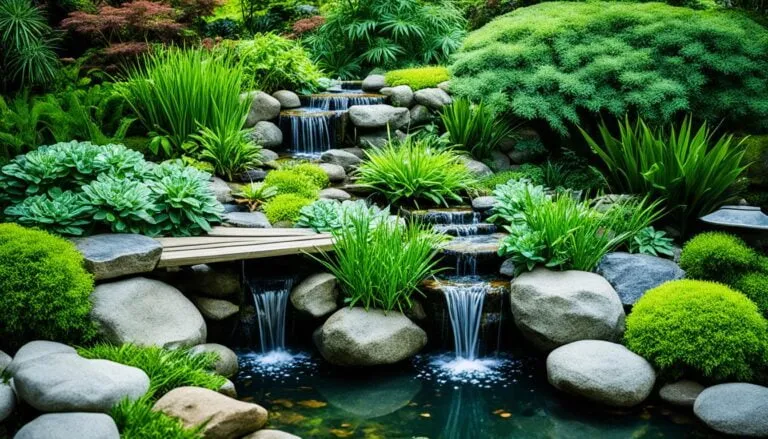Landfills are overwhelmed, with over 30 percent tied to food scraps and yard waste. This makes sustainable composting at home more crucial than ever. Turning compostable kitchen scraps into nutrient-rich compost helps manage waste and supports eco-friendly food waste management. This guide will show you how to decrease landfill use and care for the environment.
Key Takeaways
- compostable kitchen scraps Identifying items suitable for composting can greatly reduce household waste and landfill contributions.
- Finished compost can enrich garden soil, taking anywhere from 6 months to a year to produce, depending on the method used.
- Indoor compost bins and innovative solutions like electric composters provide options for those without outdoor space.
- Vermicomposting and trench composting are effective, low-maintenance alternatives to traditional methods.
- Understanding the balance of greens and browns is essential for successful composting activities at home.
- Properly managed composting efforts have a significant positive impact on the environment by reducing greenhouse gases.
The Importance of Composting in Reducing Landfill Waste
Composting is essential. It helps in reducing kitchen landfill waste effectively. By turning kitchen and garden scraps into compost, it reduces the amount of trash in landfills. This is important because food scraps alone make up over 22% of all waste in the US.
The Environmental Impact of Organic Waste in Landfills
Putting organic waste in landfills has a big effect on the environment. When food scraps break down without air, they make methane. Methane is a very strong greenhouse gas. It’s much better at trapping heat than carbon dioxide. Landfills are a major source of methane. So, by composting, we can lower these harmful effects.
Understanding Methane Emissions and Their Role in Global Warming
Methane emissions from rotting waste in landfills are very bad for the planet. Methane is even worse than carbon dioxide for trapping heat. It also helps make harmful ozone. By composting, we can reduce the amount of methane made. This is key in fighting global warming. It’s also vital for our waste management efforts.
So, composting is a smart way to deal with trash. It lowers methane and keeps landfills less full. It’s a simple yet effective method. Besides helping the Earth, it improves soil too. More and more people are starting to compost. This shows we are moving towards living in a more eco-friendly way. Everyone’s effort counts, from those at home to whole communities.
What Are Compostable Kitchen Scraps?
Homeowners who care about the environment can find value in their kitchen waste. This waste includes biodegradable food scraps like fruit peels and more. It’s key to turning trash into useful items and cutting down on harmful landfill gases.
Potential of Biodegradable Food Scraps as a Resource
Biodegradable food scraps are items like fruit peels, tea leaves, and eggshells. They are easily composted to create soil full of nutrients. This rich soil helps plants grow strong. To learn about making compost from kitchen waste, check out this helpful guide.
Categories of Compostable Kitchen Waste
Kitchen waste is split into greens and browns for composting. Greens are food scraps and coffee grounds. They add nitrogen. Browns, which are things like leaves, provide carbon. The right mix of these ensures quick decomposition.
| Type of Waste | Category |
|---|---|
| Fruit and vegetable peels | Green |
| Coffee grounds and filters | Green |
| Tea bags | Green |
| Eggshells | Brown |
| Grains such as bread or rice | Green |
To compost well, one must understand the types of kitchen waste that work best. This knowledge speeds up the composting process and makes the soil better for your garden.
Compostable Kitchen Scraps Sustainable Composting at Home: Getting Started
Starting a green kitchen is all about using your food scraps wisely. This basic step helps the earth by reducing waste. Knowing how to compost at home is key. It’s for anyone who wants to turn their scraps into rich soil.
You can compost no matter where you live, be it a big house or a small apartment. Many composting options are out there. They fit well with various living spaces.
Kitchen scraps like fruit peels, tea bags, and eggshells can be composted. This enriches the soil. It also cuts down on waste in dumps. This helps fight climate change because less methane, a harmful gas, is released.
- Vermicomposting: This uses worms and is great for small spaces like apartments.
- Bokashi composting: A method done indoors without bad smells, perfect for some outdoors.
- Backyard composting: Best for those with more space. You can compost a lot more, including yard waste.
Using green kitchen practices is good for the planet. It lowers waste and gardening costs. But not all food scraps are good for compost. Avoid putting in things like meat, dairy, and greasy foods. They can cause problems.
Composting is a big win for both the environment and your garden. It helps reduce trash in dumps. Thus, it lowers your impact on the planet. Plus, it supports growing plants in a natural way.
Types of Compost Bins: Choosing the Right One for Your Home
Choosing an eco-friendly way to get rid of trash is key. To match your home and lifestyle, decide between a backyard composting area and an indoor compost bin. There are lots of types of compost bins to fit everyone’s needs.
Backyard vs. Indoor Composting Solutions
Got some outdoor space? Then backyard composting might be for you. It allows for big compost areas like bins or tumblers. For those in apartments or small homes, indoor compost bins are a perfect fit. They keep smells in check and are space-friendly. Both methods help turn food scraps and yard waste into useful compost.
Features of an Efficient Compost Bin
A good compost bin speeds up the breakdown of natural waste. It also keeps a good mix of air and moisture. Look for easy ways to add food scraps and mix the compost, plus sturdy builds to keep pests out. Here are some of the best models out there:
| Type | Model | Price |
|---|---|---|
| Stationary | D.F. Omer Garden Composter Bin | $88.27 |
| Tumbling | VIVOSUN Outdoor Tumbling Composter | $94.99 |
| Worm Compost Bin | 5-Tray VermiHut Plus | $109.95 |
| In-Ground | DIY In-Ground Bin | $10 |
| Food Waste Digester | Green Cone Solar Waste Digester | $249.95 |
| Electric | Lomi | $499 |
Find the best composting choice by thinking about what you need and what your space is like. Understanding the features of different types of compost bins helps you do your part in reducing waste.
Compostable Kitchen Scraps Green Kitchen Practices: How to Sort and Store Scraps
Making your kitchen green is key to a better planet. Sorting kitchen waste well makes recycling and composting easier. It also cuts down on how much waste we make. By doing this, your kitchen can be a green role model.
First off, you need to know what to do with kitchen scraps. Things like vegetable peels, fruit skins, and used coffee grounds can go into a compost bin. It’s important to mix green and brown materials right for the compost to be good for your garden.
Freezing some scraps is another good idea. This stops pests and bad smells. Freezing meat and fish scraps keeps insects away until you can dispose of them safely.
- Use airtight containers or compost bins in your kitchen for daily scraps.
- Keep greens and browns separated to make better compost.
- Smart bins with sensors can help make waste sorting easier.
Following these steps helps reduce kitchen waste and supports nature. By using green kitchen practices and good compost bin tips, you lessen waste. You also help grow plants and improve soil.
In the end, sorting and storing kitchen waste the right way is vital. These actions help keep our planet healthy. With the right knowledge and tools, we can all help the Earth.
Organic Waste Recycling: Understanding Browns and Greens
To boost a compost pile’s health and recycle organic waste well, you must know about ‘browns’ and ‘greens’. Balancing these materials creates an ideal compost mix. This mix is key for breaking down organic matter efficiently.
Creating the Perfect Balance for Rich Compost
Mixing the right amount of browns, like dried leaves, with greens, such as kitchen scraps, is vital. A good rule of thumb is 3 to 4 parts of brown to 1 part green. Browns add needed air and structure to your compost. They also soak up extra moisture. Greens supply essential nitrogen, which feeds the tiny organisms breaking down the waste.
Common Mistakes to Avoid in Compost Ratios
Using too many greens in your compost is a mistake. It can cause bad smells and slow down decomposition. Too much greens make an environment low in oxygen, perfect for bad bacteria. But, too few greens make the compost dry and slow. A balanced mix is not just for quick composting. It also keeps odor and health risks low.
Knowing how to balance browns and greens improves home composting. It leads to a better way of recycling organic waste.
Composting Challenges: Managing Odors, Pests, and Common Issues
Composting offers great benefits like reducing waste and enriching soil. But, it can bring challenges too, such as dealing with compost odors and compost pests. Overcoming these challenges requires smart, informed approaches for a sustainable and efficient process.
To tackle odors, maintaining the right carbon to nitrogen (C/N) ratio is key. A proper mix of carbon-rich and nitrogen-rich items boosts the good bacteria’s work. This mix reduces bad smells and keeps decomposition effective. This is a cornerstone for sustainable composting solutions.
Airflow and moisture control are crucial for odor management too. Lack of air can create stinky, slow compost. If your compost is too wet or not wet enough, it might smell bad. It should be as moist as a wrung-out sponge.
- Adequate bin ventilation prevents anaerobic conditions.
- Maintaining moisture levels can control odors and deter pests.
- Burying food scraps deep within your compost can reduce surface attraction for pests.
- Choosing the right container optimizes composting conditions, enhancing decomposition and minimizing disruptions.
More and more people are composting indoors all year round. It’s a great way to keep waste out of landfills. But it needs careful management to prevent odors and keep compost pests away. This includes regularly balancing the compost container’s contents.
To beat pests and keep your compost area clean, a good container is a must. Having something that’s covered well prevents animals from getting in. They won’t be able to eat or nest in the compost if it’s properly sealed.
Adopting these methods helps navigate through common composting issues. This leads to sustainable composting solutions and top-notch compost for your garden.
Compost Bin Tips: Achieving Effective Decomposition
About a third of our waste at home is food scraps and garden leftovers. Handling this organic matter the right way is key to keeping our planet healthy. Using tips to make your compost bin work well is important. This helps turn waste into something useful, all while helping the environment.
One key point is to make sure there’s enough air in your compost. This helps break down the waste quickly. It also helps good bacteria do their job. Keep your compost just moist, like a damp sponge, not wet. This will make the decomposition process work better.
Best Practices for Aeration and Moisture Control
Finding the right balance of air and water in your compost is important. Air helps avoid smelly situations in your compost, while water makes sure the bacteria have what they need. To get more air in, mix up your compost with a tool or turn it. This step is crucial for aeration and smells control.
Remember that too much water is bad for your compost. It needs to be just moist. If it’s too dry, the waste takes longer to break down. So, water and air are a must for successful composting.
Turning the Compost: Frequency and Techniques
How often you should turn your compost depends on a few things. For example, how big your pile is, the weather, and what you put in it. A good rule of thumb is to turn it when it heats up and again when it cools down. This helps mix the waste well. Adding different materials, like paper or leaves, helps everything break down evenly. Plus, it cuts down on waste. By regularly turning your compost and adding layers well, you’re preparing the best soil for future plants.













